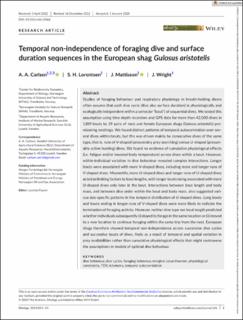Temporal non-independence of foraging dive and surface duration sequences in the European shag Gulosus aristotelis
Peer reviewed, Journal article
Published version

Åpne
Permanent lenke
https://hdl.handle.net/11250/3049304Utgivelsesdato
2023Metadata
Vis full innførselSamlinger
- Publikasjoner fra CRIStin - NINA [2364]
- Scientific publications [1392]
Originalversjon
10.1111/eth.13362Sammendrag
Studies of foraging behaviour and respiratory physiology in breath-holding divers often assume that each dive cycle (dive plus surface duration) is physiologically and ecologically independent within a series (or “bout”) of sequential dives. We tested this assumption using time depth recorders and GPS data for more than 42,000 dives in 1289 bouts by 39 pairs of male and female European shags (Gulosus aristotelis) provisioning nestlings. We found distinct patterns of temporal autocorrelation over several dives within bouts, but this was driven mainly by consecutive dives of the same type, that is, runs of V-shaped (presumably prey searching) versus U-shaped (presumably active hunting) dives. We found no evidence of cumulative physiological effects (i.e. fatigue and/or lowered body temperature) across dives within a bout. However, within-individual variation in dive behaviour revealed complex interactions. Longer bouts were associated with more V-shaped dives, including more and longer runs of V-shaped dives. Meanwhile, more U-shaped dives and longer runs of U-shaped dives acted as limiting factors to bout lengths, with longer bouts being associated with more U-shaped dives only later in the bout. Interactions between bout length and body mass, and between dive order within the bout and body mass, also suggested various size-specific patterns in the temporal distribution of U-shaped dives. Long bouts and bouts ending in longer runs of V-shaped dives were more likely to indicate the termination of foraging activity. However, neither dive type nor bout length predicted whether individuals subsequently (i) stayed to forage in the same location or (ii) moved to a new location to continue foraging within the same trip from the nest. European shags therefore showed temporal non-independence across successive dive cycles and successive bouts of dives, likely as a result of temporal and spatial variation in prey availabilities rather than cumulative physiological effects that might contravene the assumptions in models of optimal dive behaviour. dive behaviour, dive cycles, foraging behaviour, marginal value theorem, physiological constraints, TDR, telemetry, temporal autocorrelation
